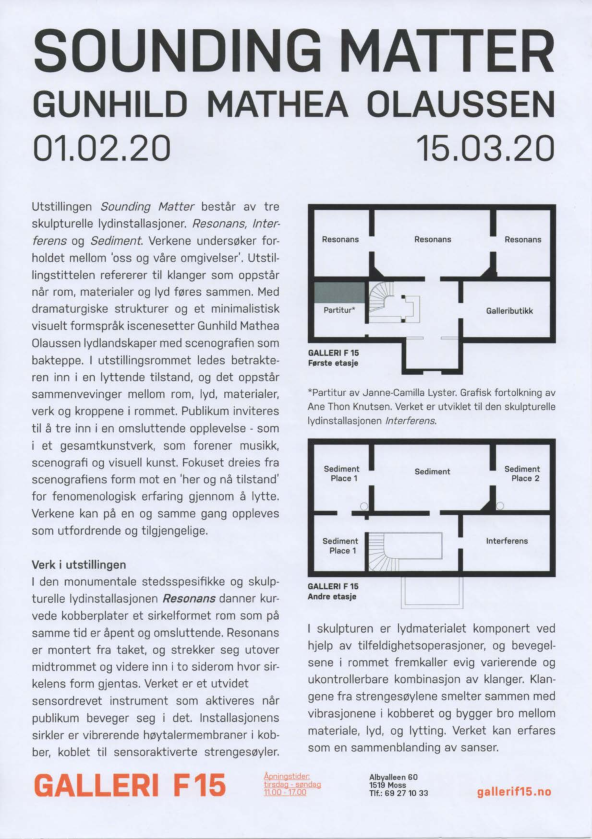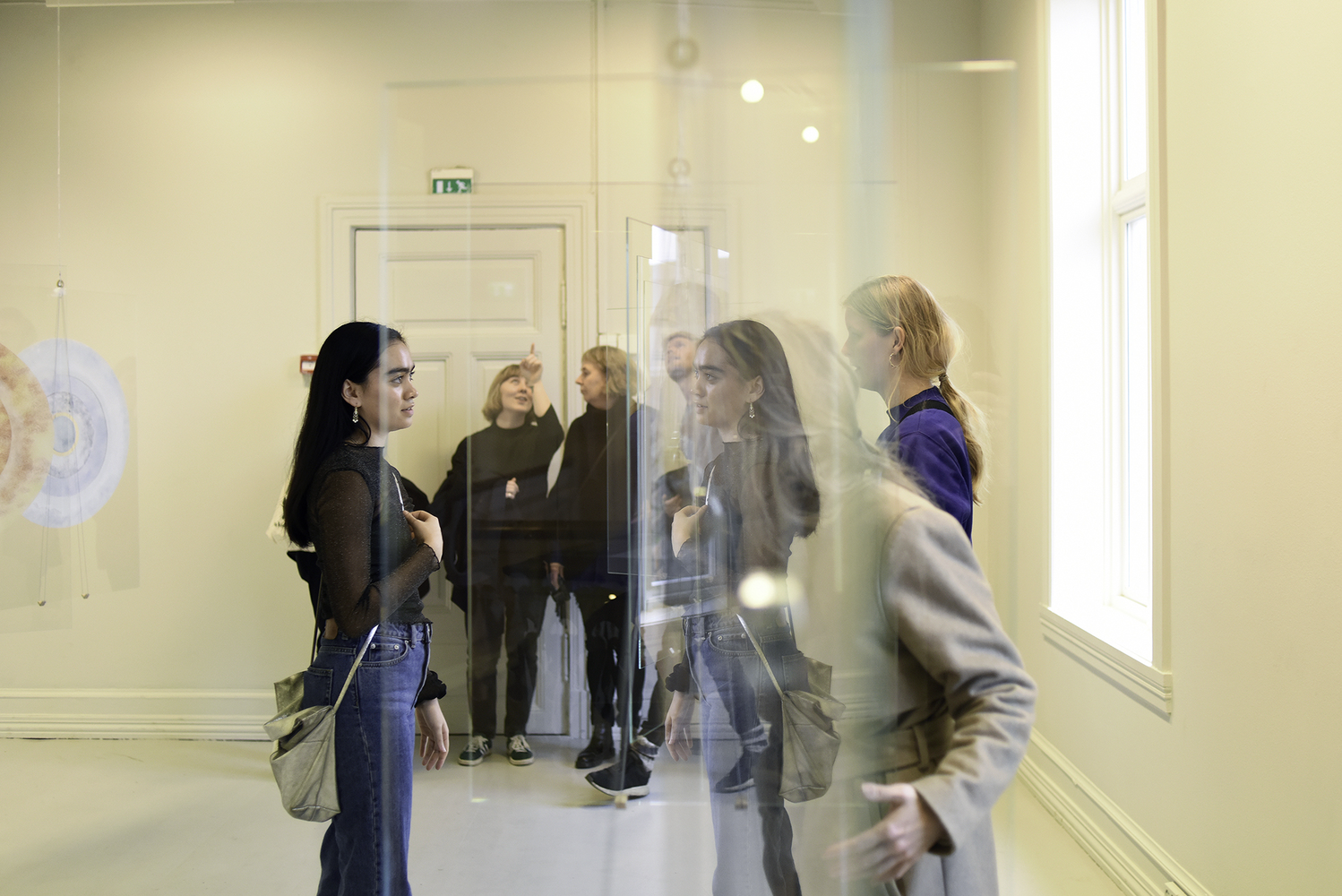SOUNDING MATTER
Gunhild Mathea Olaussen, Gallery F15 1.02 - 15.03 2020. Video: Morten Halfstad Forsberg
Please watch the video in full screen and with good headphones.
PLACE 1 & PLACE 2
Described by Nicolas W. Hughes, art mediator at Gallery F15.
Place 1 and Place 2 are so reliant on a spatial experience that they're challenging to capture in photographs or video. Nicolas W. Hughes's descriptions in this film express his perception of the works.
PHOTO DOCUMENTATION
Hold the cursor over the image for photo credits. Browse the album by clicking on the arrows beneath the frame.
The exhibition Sounding Matter was an in-depth investigation into ourselves and our surroundings.
The title relates to resonances that occur during the encounter between ourselves, spaces and materials, and to the idea of listening as an active endeavour. Listening is of crucial significance to these artistic investigations, which seek to dramatise spaces by means of sound, minimalist sculpture and dramaturgical structures.
The exhibition’s constituent works – Interference, Resonance, Sediment, Place 1 and Place 2 – appeal in a variety of ways to the materiality of our bodies; they are environments that seek to touch the zones of proximity where we are able to sense that, as humans, we participate in a fine-meshed weave with our surroundings. Sounding Matter was a solo exhibition that filled Galleri F15 in its entirety.
°
SEDIMENT
Sculpture (8 x 0.4 m)
Six concrete elements with a hint of Acrylic 1. Cast horizontally layer upon layer in white cement mixed with colour pigment and sand taken from four different geographical locations.
Sediment is a sculptural work which forms a semicircle extending the full length of the middle room on the upper floor of Galleri F 15 (see exhibition map and description of the work at the bottom of the web page). The curved shape speaks to the world outside the gallery building and enters into a dialogue with architecture and nature. The sculpture evokes associations with fallen architecture, a structure created by humans and subsequently subsumed by time and nature.
Sediment can also evoke associations with a structure which invites you to sit down on it and glance through the windows across the landscapes of Jeløya – a place for contemplation – but the sculpture is fragile, too low and rugged and not suited to that purpose: it almost becomes an obstacle to visitors. The material itself is dedicated to the contemplative space. Sediment stands there as a contour of a time that was, of traces that were left, yet it continues to shape the times ahead.
Sediment makes no inherent noise, but in this space the combined sound from all the installations in the gallery come together to create their own composition. The sound never gets too close but seems as if it is coming from next door. Sediment stands there as a witness, listening to what is happening around it.
The work has its roots in how we perceive time differently, how we age differently as our experiences and memories and the effects of our lifestyles accumulate, and how time feels different to all life and all materials. Geological accumulation is the deposition of soil transported by rivers, ocean streams, glaciers and sediments. Sediment takes its cue from these sediments and the physical time they embrace.
°
PLACE 1 / PLACE 2
Two site-specific works. Alternations of sound, space, architecture and the identity of time.
On the upper floor of Galleri F 15 are two corner rooms – two cornerstones. They are similar, but one perceives them as different in terms of temperature and acoustics, and the windows offer different views of the landscape outside. With the help of a sound composition and changes to the surfaces of the existing floors, the rooms are subtly transformed from empty spaces into physically reorientated places. A reorientation towards the building itself, to the human body as it relates to the body of the building, and to the past, present and future as an interwoven experience.
For these works, I had recordings made of the ambient sounds in the rooms – soundscapes characterised by a ventilation system, fluorescent lighting, people talking downstairs, the wind and the fjord outside. In the studio, I then analysed the soundscapes and sought to reproduce what I could hear using sand, sugar, metal and a snare drum. These composed recordings were then played back in the gallery over a quadrophonic sound system of white speakers that are fairly inconspicuous against the walls of the room. The soundtrack is confusing, true but untrue, strangely related to the room itself, but without any obvious connections.
Painted in white varnish on the floor of each of the two rooms are patterns that echo and serve as extensions of the architecture: like patches of floor bleached by the sun over time, like wear and tear, like dust or light that has collected in the corners of the rooms.
Place 2 is a circular work. The floor is filled by a large circle, created by painting the narrow spaces between the outer edge of the circle and the walls in white varnish. The soundscape is like a centrifuge of running sand, moving around quadrophonically, suggesting perhaps the sea, or the wind, although subconsciously one knows that can’t be true. The viewer finds themselves standing in the middle of the room, under a shower of white noise. Are they merging with the wind howling outside, or the waves crashing against the shore, or with time as it becomes an eternal instant, yet which always passes before it can be grasped? While the synthetic aspect is always rendered visible, leaving the viewer in no doubt that the stimuli are artificial, the question remains of whether some element of the experience is latent within the room itself.
Place 1 is a double room with an interconnecting doorway and two windows, one on either side of the building, that almost face each other from their respective spaces. It is as if the outside world on one side of the building shines, or trickles, straight into one room, where it meets whatever shines into the room from the other side. The wild fjord and the front garden in front of the gallery meet the sheltered backyard at the interface between the two rooms. Yet there is something about the slight asymmetry of the windows: you almost have to take a small step sideways to look into the room facing the backyard, which in turn means that you lose part of the view of the fjord. It is as if everything is open and transparent. Yet time is still hiding in some of the corners; the tiled stove where a fire once burnt, the sun which has shone here before, and that which lies beyond the corner of time, and which we are still unable to grasp. In this room, an abstraction of light trickling through the windows is captured in white varnish on the floor. The soundtrack in the room sounds like the fjord, but is not the fjord; like a ventilation system, but not a ventilation system; the sound of the fire in a stove in a cold room.
The second of the two rooms in Place 1 faces the backyard. It is an introverted space that serves as an access route to other spaces. It can be perceived as a kind of reverberation of the exhibition as a whole. Here we hear a composition for violin, in which the instrument responds gently to the overtones produced by the sum of all the other sounds in the gallery. A small strip of light is painted in varnish on the floor, like the reverberation of something that has just been.
°
RESONANCE AND INTERFERENCE
The works Resonance and Interference are described in detail in connection with the exhibitions at the Henie Onstad Art Centre and Lydgalleriet as well as in the descriptive material from Galleri F 15 on this page. Concerts within the installations were planned for the weekend of 14 and 15 March but had to be cancelled due to the corona virus pandemic. The installations were, however, complete in themselves, even without the concerts, and received a large number of visitors during the period when the exhibition was open.
°




















